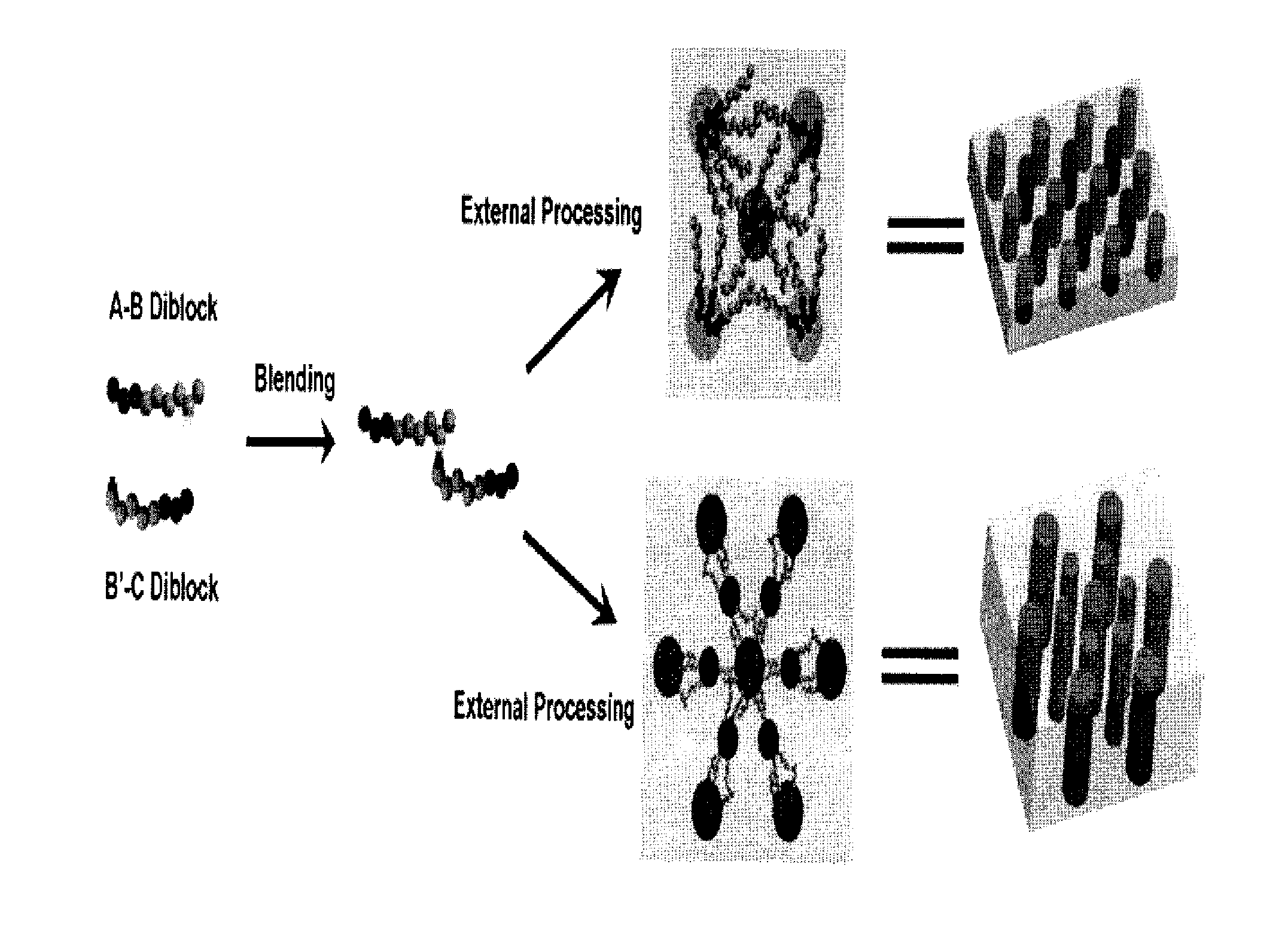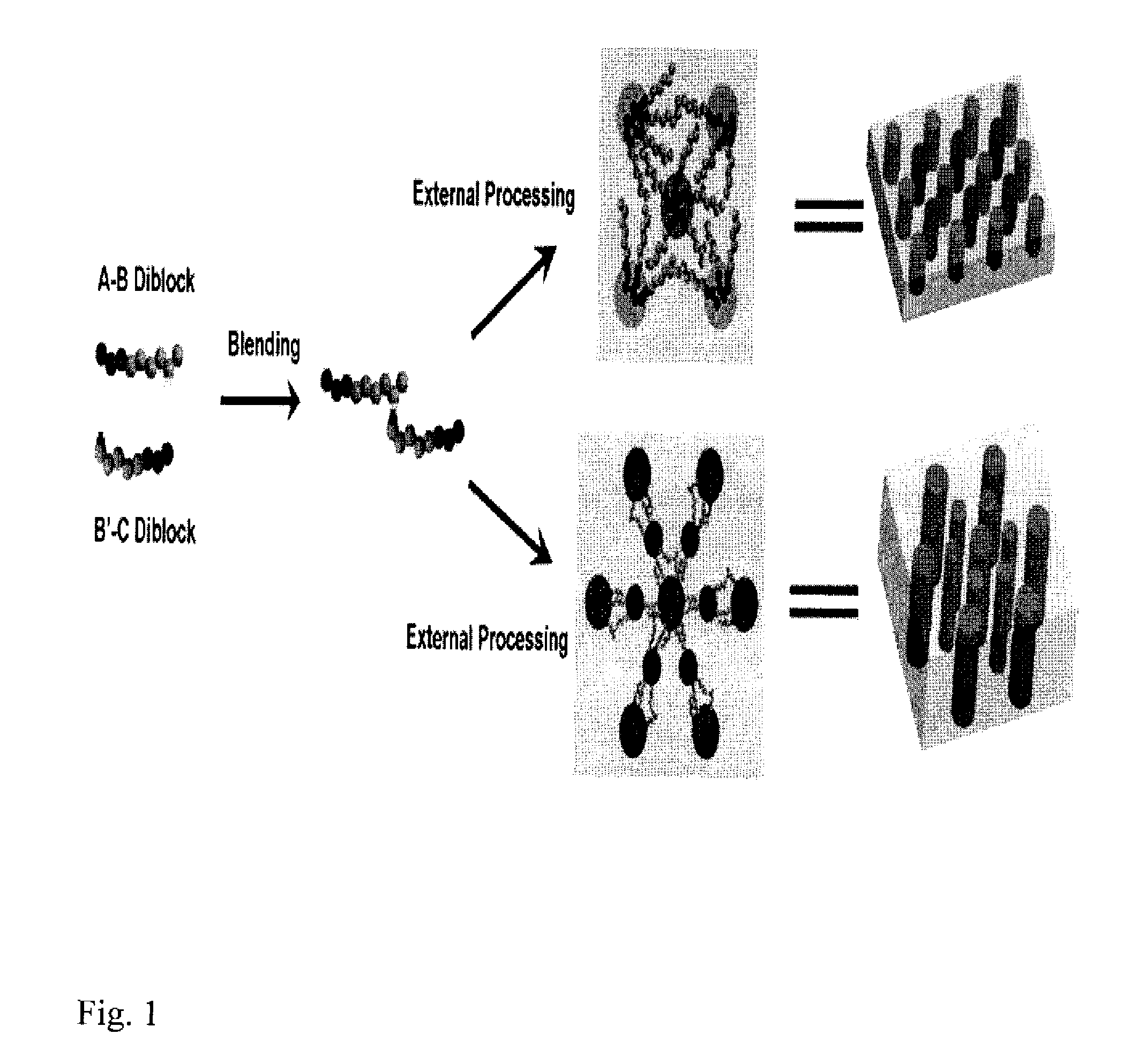Supramolecular block copolymer compositions for sub-micron lithography
a technology of copolymer composition and sub-micron lithography, which is applied in the direction of electrographic process, manufacturing tools, instruments, etc., can solve the problems of inability to continue scaling to smaller dimensions, no long-range ordering has been achieved in the thin film mixture of two chemically dissimilar block copolymers, etc., and achieve the effect of broadening the scope of block copolymer lithography
- Summary
- Abstract
- Description
- Claims
- Application Information
AI Technical Summary
Benefits of technology
Problems solved by technology
Method used
Image
Examples
example 1
[0030]We prepared and blended the two diblock copolymers poly(methyl methacrylate)-b-poly(styrene-r-4-vinylpyridine) (PMMA-b-P(S-r-4VP)) and poly(ethylene oxide)-b-poly(styrene-r-4-hydroxystyene) (PEO-b-P(S-r-HS)) in order to illustrate the invention. This blended system combines the readily-achievable long-range order offered by PEO segments in PEO-PS diblock copolymers and the photodegradability of PMMA segments in PMMA-PS diblock copolymers. 4-vinylpyridine has an attractive supramolecular interaction with 4-hydroxystyrene through hydrogen bonding, which drives the P(S-r-4VP) and P(S-r-HS) blocks to mix into a common B / B′ domain, avoiding macrophase separation. The synthesis of PMMA-b-P(S-r-4 VP) as the A-B diblock copolymer and PEO-b-P(S-r-HS) as the C-B′ diblock copolymer was accomplished as shown in FIG. 2 by reversible addition-fragmentation chain transfer (RAFT) polymerization and atom transfer radical polymerization (ATRP) respectively. Addition of styrene and 4-vinylpyridi...
example 2
[0031]A method to achieve long-range ordering for the above specific system is to utilize solvent-annealing under controlled humidity conditions. The processing is very simple and fast and does not require expensive instrumentation. The above A-B and B′-C diblock copolymers were blended, dissolved in benzene and then spin-coated onto substrates such as silicon wafers followed by solvent annealing under controlled humidity. No macrophase separation was observed. FIG. 3 shows the formation of microphases consisting of hexagonal and square arrays of cylindrical domains. The cylinders align perpendicular to the substrate and the film surface and span the whole wafer. This procedure allows for the creation of hexagonal or square arrays of cylindrical domains with low concentrations of defects over large areas. Solvent annealing with these blended polymers produced a mixed poly(styrene-r-4-vinylpyridine) and poly(styrene-r-4-hydroxystyene) (B / B′) matrix with separated A and C cylinders co...
PUM
| Property | Measurement | Unit |
|---|---|---|
| domain sizes | aaaaa | aaaaa |
| size | aaaaa | aaaaa |
| size | aaaaa | aaaaa |
Abstract
Description
Claims
Application Information
 Login to View More
Login to View More - R&D
- Intellectual Property
- Life Sciences
- Materials
- Tech Scout
- Unparalleled Data Quality
- Higher Quality Content
- 60% Fewer Hallucinations
Browse by: Latest US Patents, China's latest patents, Technical Efficacy Thesaurus, Application Domain, Technology Topic, Popular Technical Reports.
© 2025 PatSnap. All rights reserved.Legal|Privacy policy|Modern Slavery Act Transparency Statement|Sitemap|About US| Contact US: help@patsnap.com



